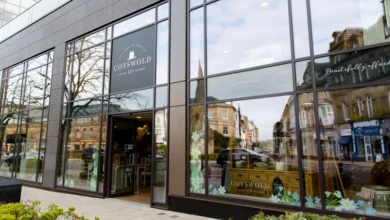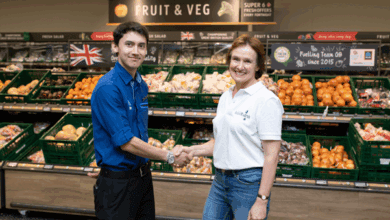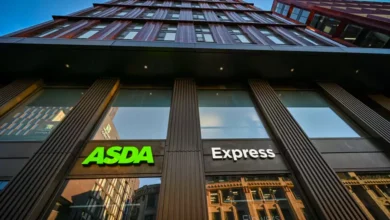Tim Mason: ‘This will be an Omnichannel Christmas’
Former deputy CEO of Tesco and current Eagle Eye CEO, Tim Mason, talks about how he came up with the original Tesco Clubcard and what is meant by ‘omnichannel Christmas’ when describing consumer spending patterns

Register to get 1 more free article
Reveal the article below by registering for our email newsletter.
Want unlimited access? View Plans
Already have an account? Sign in
Can you tell us a little bit about your career in retail?
I started out at Unilever in 1979, before joining Tesco from 1982 to 2012. During that time, I held a variety of senior management positions, including being UK CMO, CEO of Fresh and Easy LLC, and eventually deputy CEO of Tesco.
In addition to helping create Tesco Express, Personal Finance and Tesco.com, I am extremely proud to have led the launch of Tesco Clubcard in 1995, creating the world’s first major grocery loyalty programme.
Fast-forward to 2023 and I recently celebrated my seventh anniversary as CEO of Eagle Eye, a leading SaaS technology company that empowers personalised marketing and loyalty solutions used by retailers worldwide. We have witnessed some profound changes to the industry since I joined Eagle Eye, many driven by the very technologies that we are at the forefront of developing and introducing to retailers.
On this subject, I recently co-authored an updated edition of Omnichannel Retail – How to Build Winning Stores in a Digital World, which was published in September. The new edition was inspired by my experience at both Tesco and Eagle Eye, and the many changes that have impacted the retail sector since the original edition, published in 2019.
During your time at Tesco as deputy CEO, how did you come up with the original Clubcard idea? What inspired you and what was the reception on launch?
In 1992, Sir Terry Leahy was appointed marketing director on the Tesco main board, and later he appointed me as marketing operations director. He commissioned a major research study to understand Tesco’s place in the market and its role for the consumer. This informed several new campaigns within the company, including the ‘Every Little Helps’ strategy, which was centred around small improvements based on this research data and a renewed focus on the customer.
This strategy reached its apotheosis in 1995 with the launch of the Tesco Clubcard loyalty scheme. The reception was very positive, largely because we created substantial value for the customer – at least 1% back on all their shopping, with the opportunity to earn more than that through promotions, partner rewards and more. The programme’s aim – To create value for the customer to earn their lifetime loyalty – was informed by customer data generated by Clubcard and driven by its direct marketing connection to the customer, which delivered the next decade or more of growth for Tesco.
It was shortly after launch when I first realised the scale of the opportunity for technology to revolutionise the way that businesses engage with consumers. I have dedicated the rest of my career to working in this space, because there is still so much untapped potential for businesses to harness the power of technology to deliver better customer experiences that are simpler for their teams to execute and cheaper for them to run.
What retail trends and consumer spending do you see cropping up this holiday season?
We’re seeing several retail trends emerging this holiday season, most notably the continued shift to browsing and spending across multiple touchpoints. According to Deloitte Digital, one-third of consumers report ‘often’ shopping in-store and online during the same purchase occasion. Utilising all channels and touchpoints will be especially popular as cost-conscious consumers search for the best deals and available offers this season. As some headlines suggest, this will be an “Omnichannel Christmas”.
In the physical store, we’ll see more widespread use of mobile as shopping becomes an increasingly ‘phone out’ experience. We also expect time-strapped consumers to make use of click-and-collect options during the busy holiday season.
One final trend to note is the projected impact of Gen Z retail holiday spending; they are expected to increase spending compared with other age groups, but they have many shifts toward non-linear, omnichannel shopping behaviours. A cohesive, digital-first shopping experience tailored to Gen Z’s online and in-store preferences, is imperative for retailers to consider.
In your opinion, how can retailers incorporate consumer solutions for holiday shopping?
One of the best ways to improve overall customer connection and experience is by leveraging consumer data to deliver personalised messages and promotions. Personalisation is also the most economical way to drive the behaviour you seek.
Personalised, value-added promotions and communications across channels drive sales and profitability, even in a high-price environment. If a retailer knows what their best customers want and can incentivise them to purchase based on that insight, retailers can grow revenue without resorting to across-the-board discounting. Personalised and perfectly timed discounts, incentives or rewards, help retailers engage or activate the right customers in the right ways, which helps retailers grow their businesses profitably.
This is an example of the DIAL model in action – Data leading to Insights that power Actions that drive customer Loyalty – which other retailers have implemented, and a concept we cover extensively in the latest edition of Omnichannel Retail.
Can you tell us about some ways in which global retailers and brands have used technology to change how they attract and engage with customers?
Global retailers are identifying more ways to integrate mobile into the in-store experience and are also leading the way when it comes to using technology to enhance customer experience. Mobile scan-and-go capabilities are increasing in popularity, especially in the grocery sector.
Examples of retail leaders leveraging scan-and-go and other mobile capabilities to improve the customer experience and reduce friction during the in-store experience include:
Asda – to celebrate the first year of their Asda Rewards programme, they launched an in-app gamified campaign, Spin to Win, giving every customer who spent £5 during one visit to earn a spin for a chance to win up to £100. This was hugely popular across the customer base and drove significant engagement in the programme as a whole
Nike – The Nike app augments the shopping experience, acting as a digital companion to the customers’ in-store shopping trip, enabling faster service, personalised recommendations, exclusive offers and more.
Starbucks – The much-lauded Starbucks app gives customers the ability to pre-order, pay, earn and redeem loyalty rewards, all of which makes it easier for customers to choose to do business with Starbucks versus their competitors in a highly competitive market
Digitally augmenting physical storefronts to create more intelligent retail spaces will be critical for attracting and engaging with customers moving forward, so keep an eye on those global brands making inroads here. Establishing a one-to-one connection with customers through their own personal devices in the store allows the retailer to capture more data, personalise messages, and move into performance marketing as opposed to basic broadcast.
Looking ahead, using mobile capabilities to present location-based and contextually driven offers and information in real-time, at the point of most utility for the consumer, will be a game changer. This is something I call ‘marketing in the moment’ and the next phase for using technology to drive customer engagement and loyalty.
A recent study by Wunderman Thompson predicted that Black Friday spending will halve this year due to the cost-of-living crisis. Do you agree with these expectations? If so, how can retailers prepare for and potentially offset reduced spending during this critical period?
There are many industry predictions emerging about holiday spending in the UK this year, including a number of more recent reports that directly conflict with the Wunderman Thompson analysis. One thing they all seem to agree on, however, is that money-saving strategies will be a top priority for consumers.
According to new reporting from Adobe, UK consumers are set to increase spending this holiday season over the same period in 2022. The report also shows that shoppers will be making greater use of deep discounts – especially during Black Friday and Cyber Weekend – along with spreading out-spending, including through ‘buy now, pay later’ options. They are also replacing premium or brand name products with store brand or value range alternatives, and shopping at discount retailers.
In my opinion, consumers are still likely to shop for their loved ones, but less likely to buy gifts for themselves compared to past holiday seasons. As highlighted by the Adobe report, we will see plenty of bargain-seeking and more traffic at discount stores. Still, I think there could be a significant uptick in promotion-associated spending. This is why retailers must shore up their promotional capabilities ahead of the season as much as they can, use data to better understand their customers, and target them with personalised promotions.







